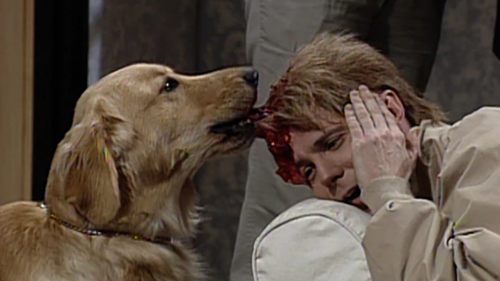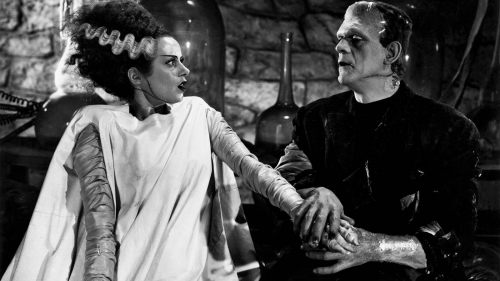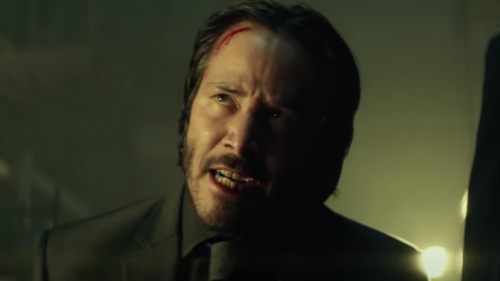The Simp Who Shagged Me
For a character whose catchphrases include “Do I make you horny," “Yeah, baby,” and “Shagadelic,” Austin Powers doesn’t really have much sex. Sure, he talks about it incessantly, but how many times does he actually go through with the thing? Instead, Austin Powers comes off like a sputtering neurotic struggling with monogamy, the true source of his own virility, and his daddy issues over the course of three increasingly cartoonish adventures.
Visually, Austin Powers is a little otter man with horrible teeth, a plunging tuft of chest hair shaped like a dick and balls, and a spectacular lack of self-awareness. Of course, these are comedies, and the joke is that the world’s sexiest man is Mike Myers in a wig. That simple premise is what made Austin Powers so ubiquitous in the culture, in ways that most comedies have never and will never be able to replicate. Other than Ghostbusters, there isn’t a comedy franchise that captured the zeitgeist like Austin Powers.
But what has allowed it to bubble back up to the surface of our collective consciousness is something deeper than the sex jokes (or the fact that they’re all on Netflix at the exact moment we all have nothing better to do). Austin Powers is worth revisiting because Myers was always so adept at finding the peculiar blindspots of masculinity and mining the humor in them, even if he had to do so in a pair of fake teeth.
From Wayne’s World’s Wayne Campbell all the way through the much-maligned Guru Pitka, Myers’s characters are curiously preoccupied with sex, but in a notably passive way. Wayne places Cassandra on a metaphorical pedestal so high, he can barely reach it. He’s in awe of her talent, is self-aware of how out of his league she is, and supports her ambition to such a degree that the entire plot of the movie revolves around Cassandra’s success more than Wayne’s. The crucial second-act complication of Wayne’s World comes when Wayne, consumed with jealousy, tries to sabotage Cassandra’s music video in order to prevent her from leaving him for a more successful, classically handsome asshole played by Rob Lowe. In The Love Guru, Guru Pitka wears a literal chastity belt for the majority of the runtime, because of his dedication to bringing love to other people.
Austin Powers might be the clearest expression of this in Myers’ oeuvre, mainly because he kept such firm control over the creative trajectory of his most memorable, lasting creation. On the surface, these movies work as pastiche, parody, and extensions of ideas that could easily have been confined to SNL sketches and never become more than that. The foundation of Austin Powers is that of a fish-out-of-water comedy in which a lascivious sex pest from the '60s is frozen and wakes up in the far more repressed 1990s. It’s Demolition Man, Time After Time, Diamonds Are Forever, Encino Man, and Blow-Up thrown into a blender. The results are best consumed quickly, lest they spoil from sitting out too long.
That’s the level Austin Powers operated at for most people. The farther they got away from that core sketch premise, the less satisfying they became for general audiences. Myers would recycle jokes, and relegate Austin to supporting status thanks to a cavalcade of questionable supporting characters — some of them also played by Myers (boy, did Goldmember not work at all). As the films grew in ambition and their budgets swelled, they appeared to get dumber and less focused. The Spy Who Shagged Me and Goldmember suffer compared to the relative narrative efficiency, comedic brilliance, and freshness of the original, but they both do exactly what Myers swears all of his films do. They make you think, if you’re willing to take them seriously for 10 minutes.
By all accounts, Mike Myers takes himself seriously, even if you don’t afford his films the same courtesy. Months before the 2008 release of The Love Guru, which halted Myers’s run on top of the box office, he told Entertainment Weekly that the film most critics called witless was “a delivery system for some wonderful ideas.” One might take issue with a filmmaker tooting their own horn for a motion picture featuring characters named “Guru Tugginmypudha” and “Jacques "Le Coq" Grandé,” but Myers seems to sincerely believe in the inherent value of his work. In a 2014 GQ profile, Myers comes off less like a broad comedian reared on the commercial tradition of SNL and more like a reclusive, contemplative artist rounding into middle age. Sincerity is Myers’s greatest gift — that he can commit to discovering the humanity in the inhuman and making cartoon characters come alive.
The first Austin Powers movie spends the majority of its runtime deflating its titular hero. He doesn’t fit anyone’s modern '90s ideal of sexuality. He dresses like Roman Polanski on his wedding day. He’s really into Swedish penis enlargers (in fact, they are his bag, baby). At first, Austin comes off as the most annoying character in his own movie. He runs around screaming about fucking all day, like a teenager who accidentally popped one of his dad’s Cialis pills. Even Vanessa, the love interest played by Elizabeth Hurley, can’t stand him. It isn’t until Austin shows her a night on the town in Las Vegas that Vanessa starts to see what her mother, who was Austin’s Emma Peel-esque sidekick in the '60s, saw in him. (As an aside, I could write a whole 2,000 words on how weird it is that Austin falls in love with his platonic best friend/co-worker’s daughter.)
The pivotal moment where we, the audience, see something in Austin takes place at the end of that date. Vanessa is drunk, fading in and out of coherence. Our hero rejects Vanessa’s compromised advances and they go to sleep. If Austin Powers really was Roman Polasnki, I doubt he'd be nearly as respectful. While the first act makes Austin out to be a repellant perv, we learn that he, at the very least, believes in consent and the fine art of legitimate seduction. He was even able to work side by side with Vanessa’s married mother without trying anything unsavory. Austin doesn’t possess and dispose of women the way James Bond did. Like Wayne Campbell before him, Austin is a proto-simp figure (in the most positive sense of the term), going out of his way to fawn over the women in his life. Even if the real history of the Swinging '60s is tainted by shameful behavior and misogyny, Austin arrives in the '90s as the ideal version of that brief period of our cultural history. By the end of the film, Vanessa has taught Austin the value of monogamy, safely merging the best parts of the '60s and the '90s’ conceptions of love.
Of course, most of that gets chucked into the bin for the sequel, The Spy Who Shagged Me, which kills off Vanessa in a pre-credits gag. For anyone charmed by the character development in the original, the follow-up dispenses with what you liked in favor of a convoluted time travel plot involving Dr. Evil stealing Austin’s manhood (aka his “mojo”). Austin’s mojo takes the physical form of a pinkish liquid that is extracted from his still-frozen body in the '60s by the grotesque henchman “Fat Bastard.” Dr. Evil, the absentee father who replaces his own son with a murderous clone, believes Austin always defeats him thanks to this intangible joie de vivre which the film makes tangible. With Vanessa gone, Austin decides to give up on monogamy and start shagging properly again, until he realizes his mojo is gone. He can’t perform with any of the women who throw themselves on him, including the film’s love interest, Felicity Shagwell (Heather Graham, who can barely keep up with Myers in every scene).
The plot wraps up when Austin finds out he doesn’t need his mojo, because it’s been inside him this whole time. This makes no sense, but the movie isn’t designed to make sense. Whatever it is that makes Austin desirable is beyond his understanding or control. The Spy Who Shagged Me isn’t about plot mechanics. It’s a joke machine that gamely tries to articulate a crisis of confidence that even the most successful people go through. The Powers trilogy is an extended meditation on Mike Myers’s own foibles and hangups. Dr. Evil’s fraught relationship with his son, Austin’s mojo, and even the gross-out humor of Fat Bastard are rooted in something subconscious. Myers himself claims Fat Bastard was inspired by his own self-hatred over his constantly yo-yoing weight.
The third and final film, Goldmember, introduces Michael Caine as Austin’s (and Dr. Evil’s) own absentee father, Nigel Powers. Nigel isn’t around to raise Austin and gives Dr. Evil up for adoption. His is a coarser, more traditional manliness, one that is defined by self-interest first and foremost. Myers’ own inadequacy is once again at the heart of an Austin Powers film, but this time, it’s very blatantly about his childhood. Myers told a pre-canceled Charlie Rose, “My mom would say… ‘Everyone in the house step forward who’s funny. Not so fast, Michael.'” Being told he wasn’t funny surely contributed to Myers’s adult career choices in the same way that we see young Austin driven to be an international man of mystery like his father.
The climax of Goldmember isn’t the action that follows, but the catharsis of Nigel, Dr. Evil (or Dougie, as he calls him), and Austin embracing. Sure, the film runs so many jokes into the ground and wastes a bunch of time on pointless bullshit like the Goldmember character and a romance between Austin and Foxy Cleopatra (Beyonce, who also gets totally lost opposite Myers) that is devoid of chemistry. But when it accepts what it’s really about, the movie works.
All of this is no excuse for that scene where Austin drinks Fat Bastard’s liquid shit, the people endlessly quoting the movies at college parties, or the landfill of unsold merchandise consuming our planet, but it does recontextualize the Powers trilogy into the wider filmography of one of the most fascinating comedy auteurs of his generation. Myers might not have directed any of the films he wrote, but his fingerprints are all over each and every one of them. They don’t fully grapple with masculinity and sexual politics the way modern audiences might want, but they at least offer a cagey side-eye to those issues.
While many of his peers — Bill Murray, Eddie Murphy, Jim Carrey, Adam Sandler, etc. — found artistic and commercial salvation working with younger filmmakers, Myers remains elusive and private. Besides cameos in movies like Bohemian Rhapsody, his bizarre Gong Show reboot, a documentary about talent agent Shep Gordon, and an announced Netflix series that has yet to see the light of day, Myers is off the stage. He hasn’t starred in a live-action studio film in 12 years. Instead, he’s noodling with music and painting Colonel Sanders. I can’t imagine it’s because no one wants to work with him, reputation be damned. It’s that Mike Myers is the engine for all of his work. The characters step off the page and into his body. They’re all refracted visions of the man himself. His movies are deeply personal statements suffused with silliness and camp. The only person who can write a Mike Myers movie is Mike Myers. I’m happy to wait.



